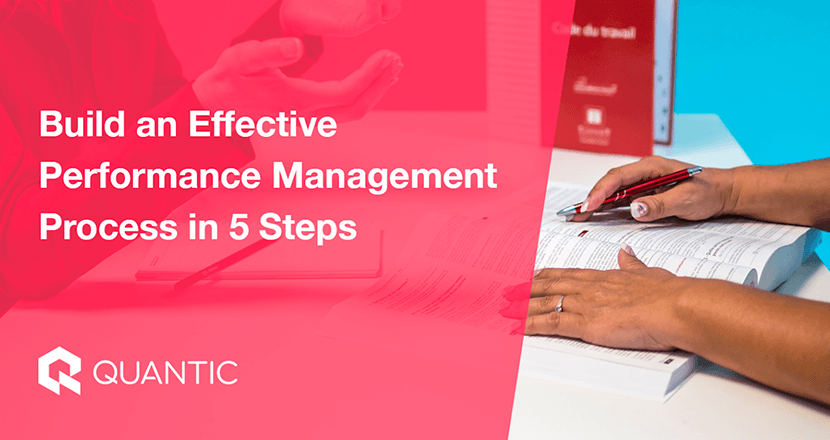BUSINESS FUNDAMENTALS
Build an Effective Performance Management Process in 5 Steps
“Don’t criticize what you can’t understand.” — Bob Dylan.
Unfortunately, it’s human nature to do exactly the opposite of that. It takes a trained individual to open their mind and allow themselves to be taught and shown someone else’s point of view before jumping straight to critical mode.
Perhaps some of your employees are ‘untrained’ in that sense. They don’t understand your routine checks on their work, and so they resist it. Maybe behind your back, but instinctively you sense they do.
The braver employees may have verbally expressed that they feel like routine performance discussions are a waste of time.
Because of it, you, as a supervisor, are constantly in a dilemma.
When you become strictly results-oriented, you observe that your relationship with your subordinates suffers. On the other hand, when you direct your efforts towards their needs, including emotional ones, you may notice them slacking in goal completion.
Managers everywhere are seeking skills to gently and yet effectively manage work performance.
You’re about to learn how to build such a management process in only five steps.
But first, let’s make sure we’re on the same page concerning what performance management is.
What Is Performance Management?
And like any other form of communication, it thrives when it’s bidirectional — i.e., when your employees get to hear from you even as you listen to them.
This is an ongoing process that demands critical and creative thinking from both parties involved.
It should be set up in a way to easily recognize and cancel out redundant working methods and activities.
The modern techniques of performance management can be likened to hiring a full-time handyman to fix damages as they occur and tactfully prevent others.
Contrast this with the traditional, yearly maintenance that is prone to leave a fat invoice in hand waiting to be paid out. And on top of it: one or two critical issues requiring advanced works.
Performance Management Definition
Performance management can be defined as the overall communication process between managers and employees that is centered on planning, observing, and reviewing the employee’s system of carrying out job duties.
Employee Performance Reviews
Employee performance reviews are a formal assessment of the degree to which an employee is efficient and effective.
Your expectations as a supervisor must be clear for this and the rest of the performance management process to be a success.
However, the insistence of the review being in a formal setting is quickly losing its grip, as you will understand later on.
Employee Performance Evaluation
If we consider the whole performance management process as a test, the employee performance evaluation would be the part where the test-giver marks the test.
A good manager delights in seeing his or her employees ace the test. But if they don’t, the manager is happy to explain in detail why they didn’t and offer useful advice for the future.
Performance Appraisal
The performance appraisal is the feedback stage. One vital aspect as you comment on your team members’ performance standards is to be crystal clear in your feedback.
This is so your employee understands why they do (or do not) qualify for bonuses, promotions, or other rewards.
Performance appraisal is mainly for giving a ruling after monitoring and reviewing your employee’s competencies and abilities to meet set objectives.
What Is a Performance Management System?
Let’s be real; none of these concepts are new to any qualified person in a supervisory position.
What, then, sets apart the excellent performance managers from the rest?
The answer lies in whether or not this knowledge is organized into a system.
Neither are the leaders themselves caught off guard by the results of the process. Throughout the ongoing exercise, they can project performance appraisals for the diverse individuals under their regulation.
When the system is well-developed, employees look forward to hearing feedback about how well they’re doing and what opportunities for improvement are available to them.
Human Resources Performance Management
The duty of developing and growing such a system lies on the shoulders of HR teams.
Most employees think of Human Resources when they conflict with each other. The other aspects they associate with HR are the laying-off process, negotiating better salaries, and working conditions.
The sad reality is that where negotiation for better conditions is concerned, many employees don’t have much faith in their HR personnel to deliver or at least meet them halfway.
Don’t let this be the case in your organization.
You could instead equip your HR management with up-to-date knowledge and skills to build successful performance management systems.
While you’re at it, why not take advantage of our high reward benefit system to arm your entire HR team with the well-rounded acumen they need to advance in their jobs?
Berthine Crèvecoeur West, the CEO of Westbridge Solutions, LLC and a Quantic alumna, is a Conflict Resolution and DEI Strategist. During the conversation below, she shared various aspects, including her professional trajectory, valuable insights on fostering an inclusive work environment, and her admiration for the Quantic community.
A Performance Management Framework for Success
Without the following practices, your performance management system will collapse:
Precise Feedback
You may be diligent in giving necessary commentary in real-time as often as your employee needs it. But as long as it is vague, a loophole is introduced into the management process that may become difficult to close.
Aim to be precise with numbers and sufficient vocabulary to describe the extent to which you desire goals to be met.
Kind Regards
An open arms policy is key to the survival and growth of your performance management system.
There’s a limit to the number of times subordinates want to interact with an unkind supervisor.
Problem-Solving Technique
Exercise your team’s problem-solving muscles to avert unsolved problems and encourage an easier flow of communication.
Ian Saville, a Quantic Executive MBA student emphasises the importance of problem-solving, self-reflection, and identifying a common thread in one’s work.
The Performance Management Cycle
The Process
Step 1: Create a Performance Management Plan
Make the plan as detailed as possible, avoiding the use of ambiguous language.
The following questions will help you in this stage of your performance management plan:
- What are the main objectives of the system?
- How can the carrying out of the plan be made to blend in with daily work assignments?
- How does each part contribute to the success of the company as a whole?
- How can we develop a practical reward system?
Involve the Employees in the Process
Workers who are involved in decision-making in an organization perform better because they have a sense of belonging.
For optimum results, incorporate your employees’ points of view while the plan is still in the pipeline.
One way to do this is to tell employees about the need to build a system and then hold meetings with them to develop an effective plan.
Another approach would be to write the plan and then hand it over to them, together with the freedom to add and subtract from it.
Learn more about effective ways to captivate your employees through 8 Employee Engagement Strategies for 2021.
Step 2: Set Goals for Performance Management
Each member ought to work with their direct manager to set S.M.A.R.T goals.
Napoleon Hill defined a goal as a dream with a deadline.
Your performance management plan, written or not, will remain a dream until you break it down into actionable steps that are time-specific.
Here’s an example:
As the manager of a media and communications company, the goal you set for your sales representative could be to cold pitch to as many potential clients as possible on LinkedIn, Google, or any other platform.
But isn’t this a stronger goal? To craft convincing and friendly emails to at least ten potential clients every week that the salesperson discovers on LinkedIn, Google, or any other platform?
It certainly is. It’s measurable as much as it’s precise.
Also, using the second approach, the next step in the management process will be made easier.
In your performance management process, you’ll need to set goals for departments as well as individuals.
Step 3: Build a Performance Review System
If done well, this system will have your employees bring their work to you for evaluation.
What you need here is a fair scale to grade their performance.
Let it be known by your employee what the least acceptable standard is and what qualifies for good and excellent work, respectively.
The two main qualities that you can build your performance review system upon as a result-oriented establishment are:
Quantity
Number of pages, number of documents, the total number of hours, net profit, number of viewers, mass, average length, etc.
These are just a few of the direct measurement qualities you can use to set up a review system.
It will certainly be easier if the previous step was properly completed. All that will be left to do here is compare outcomes with initial goals.
Quality
The quality of your employee’s work is displayed mainly by the results he or she produces.
Analyzing these results, however, can prove to be a tricky endeavor.
For example, in a dynamic industry like fashion or music, an employee could produce excellent designs or beats but receive an underwhelming response from the public.
In such cases, it would help if you had a system that recognizes time invested, basics covered, and advanced methods used by the employee in question.
Step 4: Develop Strong Feedback-Giving Skills
In as much as many growth-oriented people appreciate honest reviews, most of them get demoralized when these become excessively negative.
As a supervisor, you need to learn to strike a balance between pushing your subordinates to perfection and keeping them motivated to do better.
It’s an ongoing process that calls for you to prioritize the ergonomic aspect of the workplace.
Step 5: Ongoing Employee Performance Management
For optimum results, keep the performance management cycle rolling.
The scheduled meetings aimed at planning and reviewing a better way forward are undoubtedly important.
You and your team shouldn’t, however, be limited by them.
Give Instant feedback
Ongoing management calls for a healthy level of spontaneity.
In between the formal meetings, give a lesson or two. Correct wrong practices as soon as you see them happen.
This can work to remove the awkwardness in the formal review and feedback sessions.
Make it Flexible
It’s a fast-paced world we live in, and those who take big, bold strides win faster.
Let your employees know that even a job description is subject to change if it no longer serves the company’s main objectives.
Be prepared even with your plans and systems to surf out activities that don’t bear the desired results.
Performance Management System Examples
Many organizations are installing performance management software to match the needs of virtual offices and online interactions in the workplace.
User-friendliness and integration are among the top qualities considered as measures of the quality of different management technologies.
15Five Continuous Performance Management, Reflektive, Betterworks, and Lattice Performance Management are some of the top solution-providers in this regard.
Big companies like Facebook, Microsoft, and Accenture are implementing these systems to continue winning big in their competitive industries.
The Best Performance Management Systems
HelpSystems outlines the methodology adopted by them that resulted in increasing international software bookings by 30%, increasing new product revenue from existing customers by $3 million, and growing revenue from hosted products to $1 million — among other notable achievements.
Your Ideal Performance Management Solution
To some extent, it depends on your choice of performance management tools.
And to a greater extent on the investment you make on your team.
Find out how you can also be counted among the world’s top companies that reimburse their employees for our degree programs.
Adopting a new system can be challenging. The temptation to coil back to familiar ways is high.
However, when nurtured with poise and patience, the system will develop to become a celebrated part of your work life.



